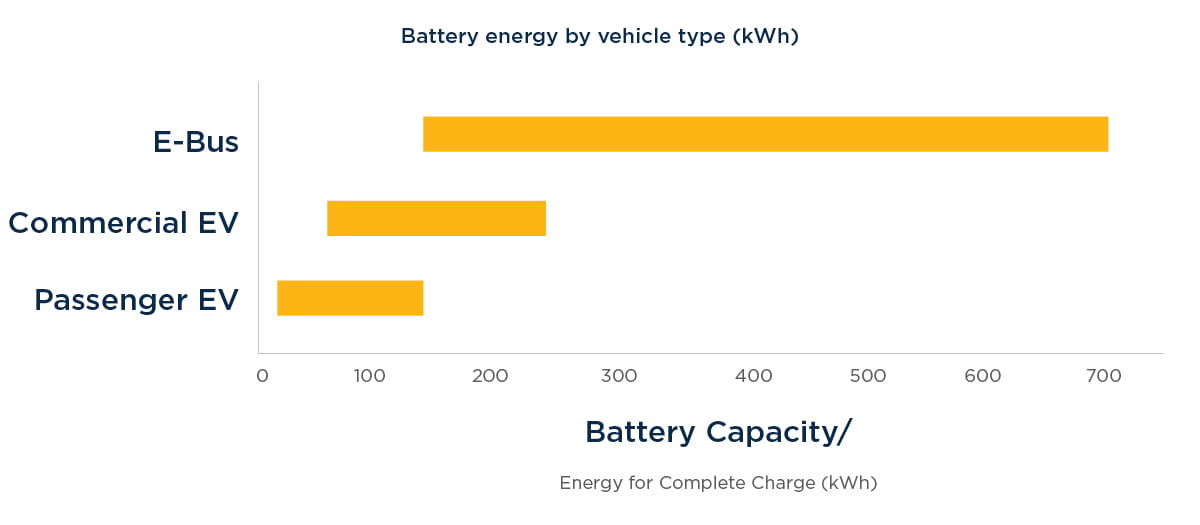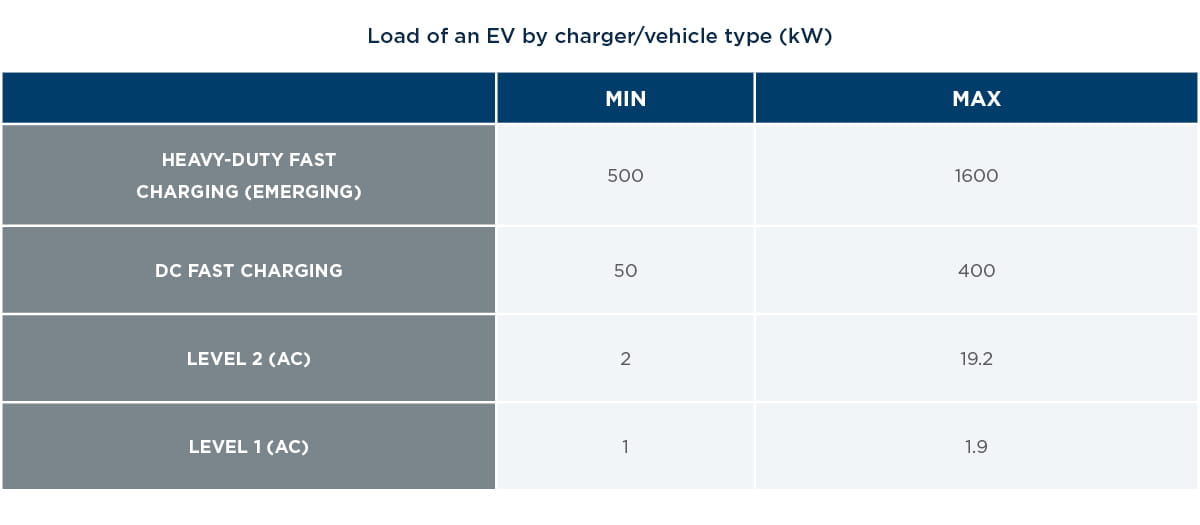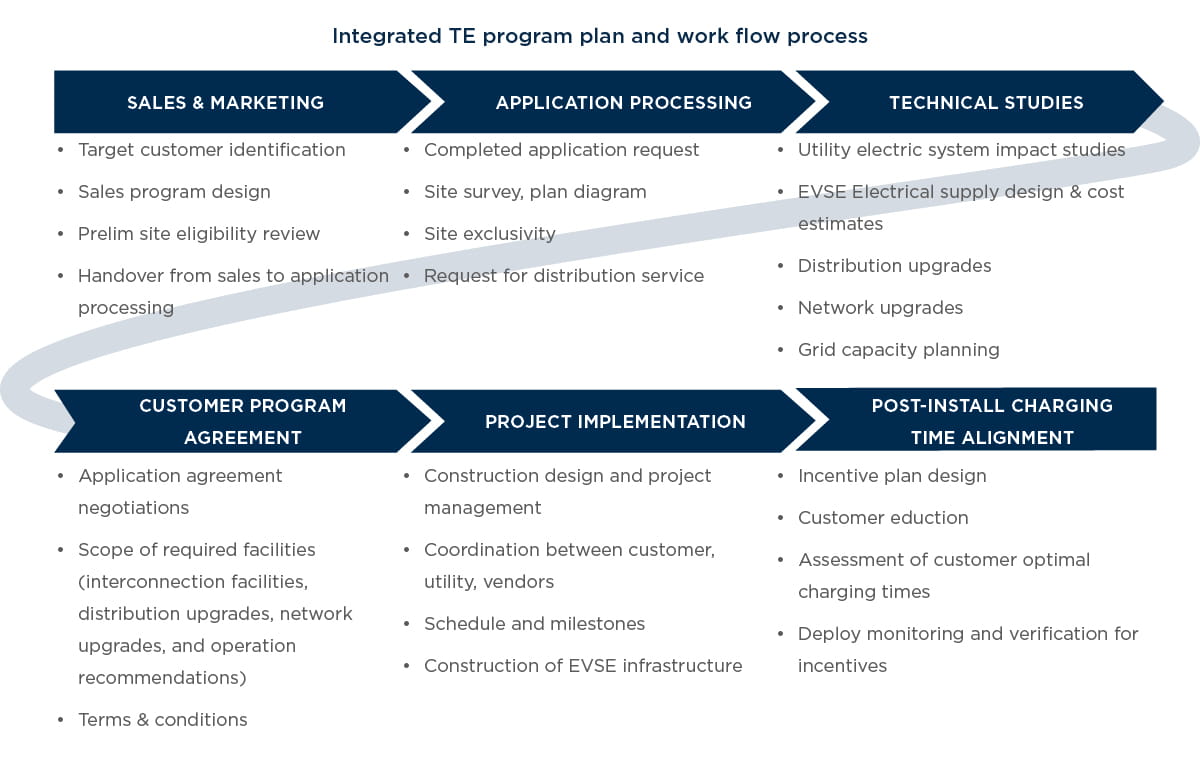
January 2019 | Report
Transportation Electrification: A Guide to Planning, Deployment, and Operations for Utilities
Electric vehicle adoption is expanding across consumer, commercial, industrial, and public sectors—which should represent opportunities for electric utilities
The rise of distributed energy resources (DERs) is an exciting and interesting opportunity for customers, and a challenge and opportunity for the utilities and the organizations that regulate them. DERs is a category of solutions that is inclusive of distributed generation sources like combined heat power (CHP), solar, and wind, as well as energy storage such as batteries. In this white paper, West Monroe Partners takes a comprehensive look at how consumers, utilities and regulators are approaching – or resisting – this energy evolution. This research examines the present and future state of DERs through multiple lenses: customer adoption and awareness; utilities’ adoption challenges and opportunities, and support and planning initiatives; and regulatory commissions’ actions, obstacles and perceptions.
We found that while the presence of DERs among residential, commercial and industrial sites is still limited, customer interest is increasing and adoption is on the brink of booming in many states across the U.S. And though utilities and regulators alike acknowledge this potential shift, in many states they have yet to settle on clear and collaborative ways to prepare for it. Factors from technology availability and cost, to public policy drivers, to pivoting business models, are contributing to the obstacles slowing DER penetration across the U.S. These issues continue to impede the industry’s ability to smoothly accommodate new energy technologies and gain acceptance. By illuminating the gaps between customer needs, utility plans and regulators’ perceptions, it is evident that these audiences must form a more united front before meaningful change can truly occur in their state.
Chapter 1: As transportation goes electric, utilities must seize opportunities
By proactively responding to EV trends, utilities can define several value streams that will drive regulatory policy and align staff around a holistic approach to transportation electrification (TE) program management. Implementing a cohesive end-to-end TE program that is able to meet the needs of the utility and customer must leverage cross-departmental collaboration and work flow.
In the United States, where transportation accounts for 29 percent of total energy consumed per year, we are witnessing a slow but steady shift from gas and diesel fuel to electricity—with EVs now forecasted to become 11 percent of all passenger vehicle sales by 2025 and 55 percent by 2040. The rising trend of transportation electrification will create tremendous opportunities for the electric utility sector.
Growth in TE is driven by a variety of factors, including declining EV prices and increased EV driving range: New EV models from major auto makers, for example, are set to increase drive ranges from an average of 114 miles (in 2015) to 275 miles by 2022. In addition, higher-capacity vehicles are coming on the scene. Electric buses from suppliers like Proterra are already in service, while electric pickup trucks by Rivian and long-haul semi-trucks by Tesla are poised to enter the market by 2020.
Accompanying the growth in quantity and variety of EVs is an acceleration in EV charging infrastructure. As shown in Figure 1, the Edison Electric Institute forecasts almost 10 million chargers of various types will be located at workplaces, commercial yards, apartment buildings, municipal parking lots, and transit depots across the United States by 2030.
Yet as consumers and businesses embrace TE at different rates, electric utilities face a decision: take a proactive stance or maintain a “wait and see” position. For some, the business case for supporting TE is clear and has already been translated into regulatory filings and policy. Proponents of utility support of TE, for instance, often point out that greater grid utilization can be achieved by virtue of the flexibility of EV loads. In the case of California, regulators approved significant funding for major IOUs based on several value streams for TE that include:
- Lower transport fuel costs to customers
- Reduced carbon emissions
- Cleaner air and environment
- Reduced health costs
- Statewide economics and job creation
What’s more, the future for those value streams is bright. By 2030, there is potential for utility load growth from EV charging to be 15 percent higher than today and capital spending on EV charging infrastructure forecast to reach $45 billion for residential, commercial, industrial, and mass transit segments—a significant portion of which goes to upgrading electric services to the customer site. As a result, utility executives and managers who guide regulatory filings and TE program managers who ramp up EV programs have a unique opportunity to influence TE growth. In the pages that follow, we will identify key challenges in designing and optimizing utility TE initiatives while highlighting best practices for leveraging an integrated program planning strategy.
Chapter 2: The impact of a new EV load — and how to plan for it
Adopting any TE program plan requires careful consideration of the impact that a new type of load can have on the grid network—both at the individual site level, as well as a system-wide level, to plan for the future. The growing diversity and quantity of EV charging locations, as shown in Figure 3, shows the potential for large concentrated loads at a variety of locations such as workplace, retail, and multi-unit dwellings.
For example, the 430 EV charging points in 2008 grew 100-fold to over 47,000 public and workplace EV charge points in 2017, with EEI forecasting 1.2 million public charging ports by 2030. Workplace parking lots will see similar growth, with companies like Google planning to convert 5 percent of the parking spaces for its 85,000 employees to EV charging stations. Meanwhile, property managers of apartment buildings are installing chargers in anticipation of future tenants who will own EVs. Retailers are also implementing EV charging infrastructure, for example Walmart announced plans to install EV chargers at 100 stores.
For larger EV charging installations, local electric infrastructure can be put under significant stress and may require upgrades—as a result TE program managers need to include engineering assessments before green-lighting a new EV charger project.
Figures 3 and 4 demonstrate these pressures by highlighting the significant range in energy capacities and charging rates for EVs, any of which can quickly yield significant system impacts. For example, the load of each EV on a Level 2 charger at 6 kW can exceed the typical load for a whole house; a workplace with 30 chargers could see a peak EV load above 1 MW; and a transit bus depot with 10 e-buses charging at 250 kW could add 2.5 MW of new load to the local feeder with 3 to 6 MWh of additional consumption on the local network per day.
The bottom line is that without a thorough TE program strategy, EV growth can lead to unanticipated impacts on grid reliability. A proactive program, however, can harness fleets of EV chargers as an aggregated Distributed Energy Resource (DER), providing a flexible controlled load that achieves greater grid utilization.
Chapter 3: Creating an integrated TE program plan
An integrated TE program plan provides TE program managers and utility executives a framework that enables coordination of work streams and communication across multiple internal departments—all while maintaining a seamless external customer experience. Given the vast scope of TE initiatives, this methodology can prove to be crucial to utilities’ success.
While there isn’t space to cover every facet of such a plan in this brief white paper—there are eight critical elements you need to know to get started:
1. Strategic road maps and regulatory filings: Drive informed cost-benefit arguments using stacked value streams.
2. Customer engagement: Establish customer participation to achieve unique TE program goals and ensure customer satisfaction.
3. Application streamlining: Develop a work flow model that efficiently manages the life-cycle of a customer EV program application.
4. Local impact on grid capacity: Design technical review processes to assess each location across a range of EV site requirements.
5. Forecasting and planning: Identify methods to forecast impact from C&I as well as residential EV charging on a grid network.
6. EV-related products and programs: Continually seek to influence EV charging behaviors and provide customer incentives to support the broader grid.
7. Organizational change: Prepare for workforce skills training in customer service, program sales, operations, and engineering approvals.
8. Cross-departmental and external stakeholder collaboration: Foster engagement while balancing internal/external voices.
Once TE programs are active and operational, an integrated TE program plan can provide a framework to avoid the pitfalls of a fragmented, siloed process. Effective TE programs aim to integrate the parallel and serial work streams of each end-to-end TE customer interaction.
While not all TE programs need follow the comprehensive process flow above, Figure 5 illustrates the life cycle of utility interactions with a potential EV customer, from customer identification and application review through live deployment.
Chapter 4: Critical success factors in program design
One key success factor we gleaned from existing TE program initiatives is the integration of separate workflow stages into a cohesive program. Utilities can optimize process workflow by clearly defining key status points, team roles, and handoffs between stages, as well as by identifying bottlenecks between stages.
Workflow management is critical when it comes to tracking status. Lack of clarity among the internal utility program team members about a status of a customer EV project leads to accumulated time delays, uncertainty, bottlenecks, and even frustration for the end-customer. Software solutions can be deployed that present a visual iconic dashboard to deliver a consistent status indicator to drive accountability and efficiency, reduce customer dropout, and maintain customer satisfaction.
Carefully vetted business case analysis tools like the one below can also provide customers with the information they need to justify a TE program commitment. For instance, an effective Business Case Analysis Tool compares the costs of converting fleets to EVs and/or installing EV charging infrastructure against the benefits of enabling critical business and sustainability decisions.
One final takeaway: TE programs must align with a utility’s core business objectives. If they’re developed optimally, these programs can help utilities acquire valuable new flexible load, grow service offerings to customers, lower customer cost, and satisfy customer demand for sustainable energy options.
Chapter 5: Lessons learned in EV program operations
To help improve the operations effectiveness of TE programs, here are some lessons learned from successful TE programs. A few examples include:
Marketing and customer targeting: Maximize the efficiency of internal staff by leveraging analytics on customer data to discover customers with the “right fit” and supply internal sales teams with optimal candidates.
Customer eligibility and application processing: Ensure alignment to program goals with accurate site and customer eligibility reviews such as cost per site and minimum charging stations, validated by site visits, legal and technical review.
Business case calculator: Enable a clear economic justification for both the utility and the customer via business case tools that tabulate customer and site attributes, providing guidance to customers on how to approach a TE cost analysis.
Technical assessment: Empower engineering teams to efficiently assess utility infrastructure costs per site, enabling the customer to more easily comply with electric codes, ADA compliance, easement issues, and metering requirements.
Contracting and legal considerations: Communicate with the customer to educate them on key contractual terms, ensuring clarity on commitments and easement requirements prior to engaging customers in final binding contracts.
Construction design: Align utility construction and engineering teams to manage risk, execute designs, permits, and cost assessments to obtain approvals needed to commence installation of EV charging infrastructure.
Integration of EV charging infrastructure/utility value alignment: Support the long-term objectives of the utility with a post-installation process that aligns the new EV load to maintain grid reliability.
Conclusion
Electrifying the transportation sector brings significant opportunities to utilities as well as their customers. By implementing a holistic approach to integrated TE program management and applying best practices from early experiences in the industry, proactive utilities will be poised to succeed in transitions to electrified transportation. By employing an integrated TE program plan, utilities can embrace TE and replace fragmented processes with unified cross-departmental efforts that can deliver customer satisfaction and overall stakeholder value.









